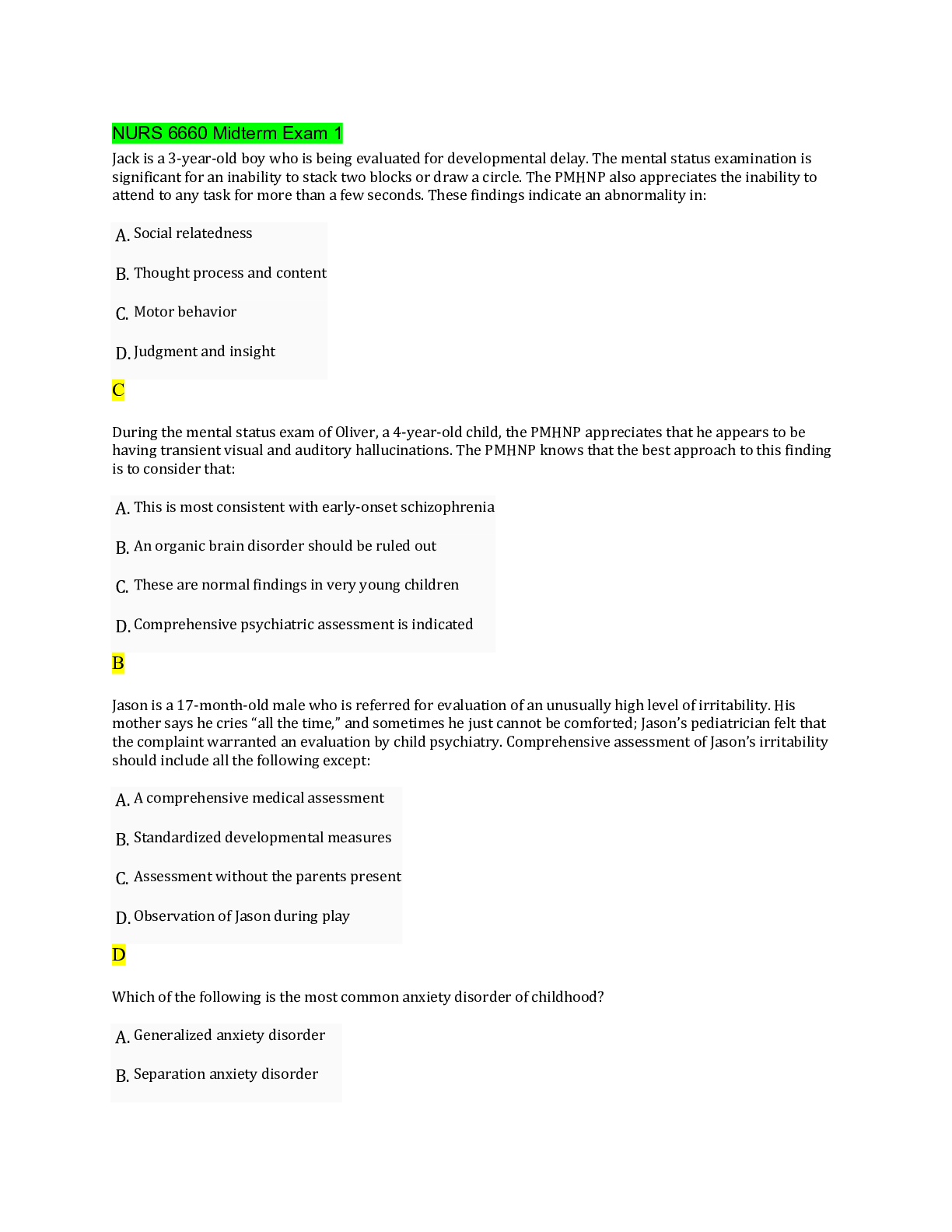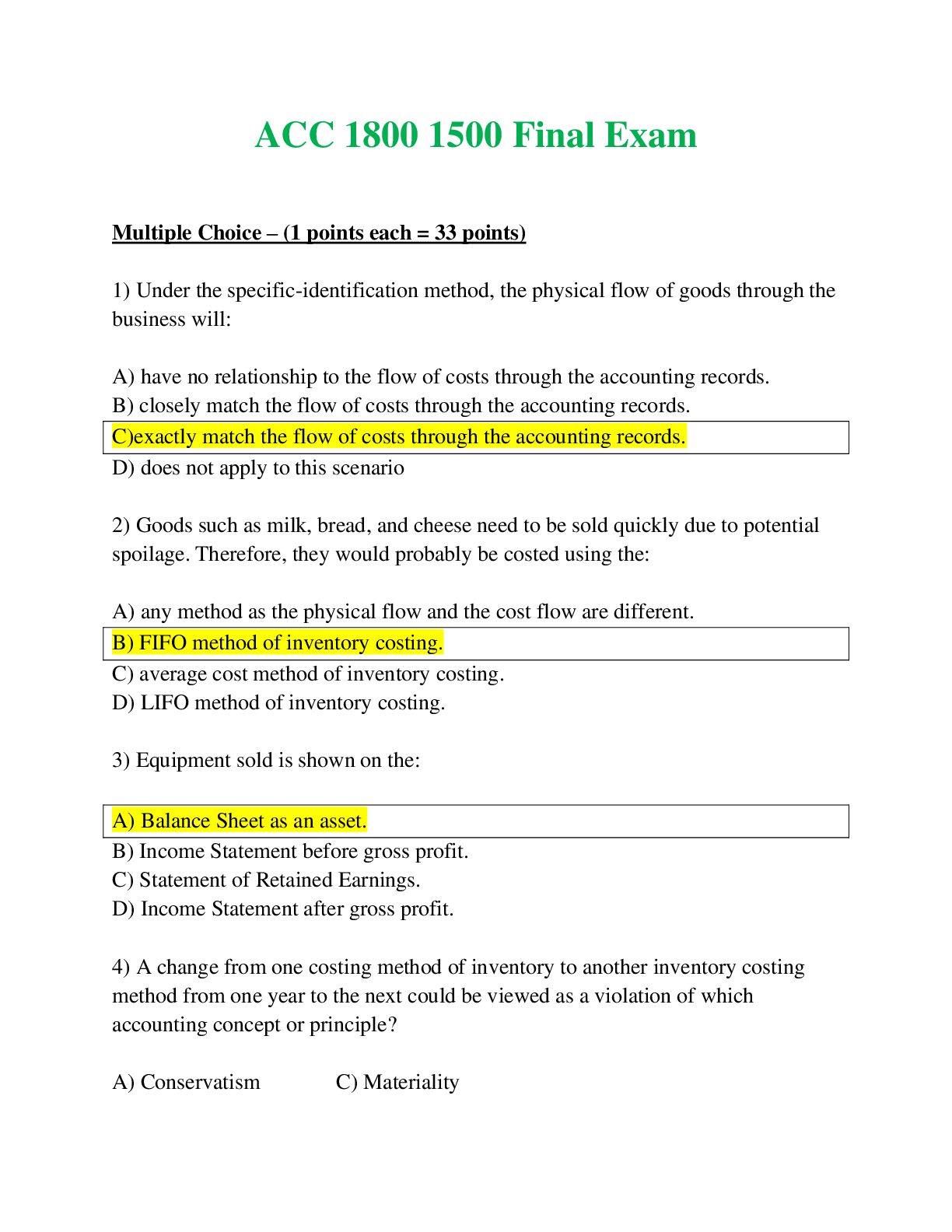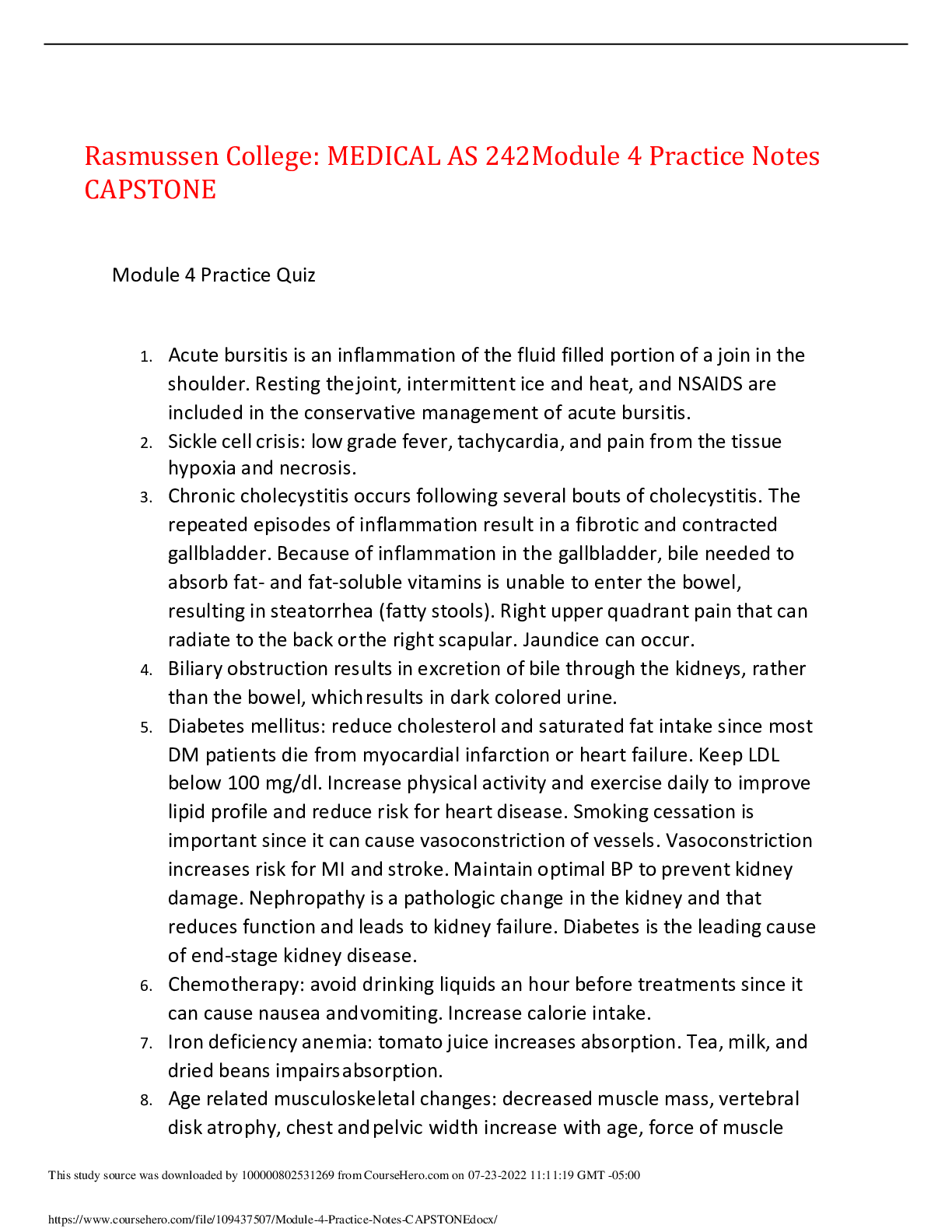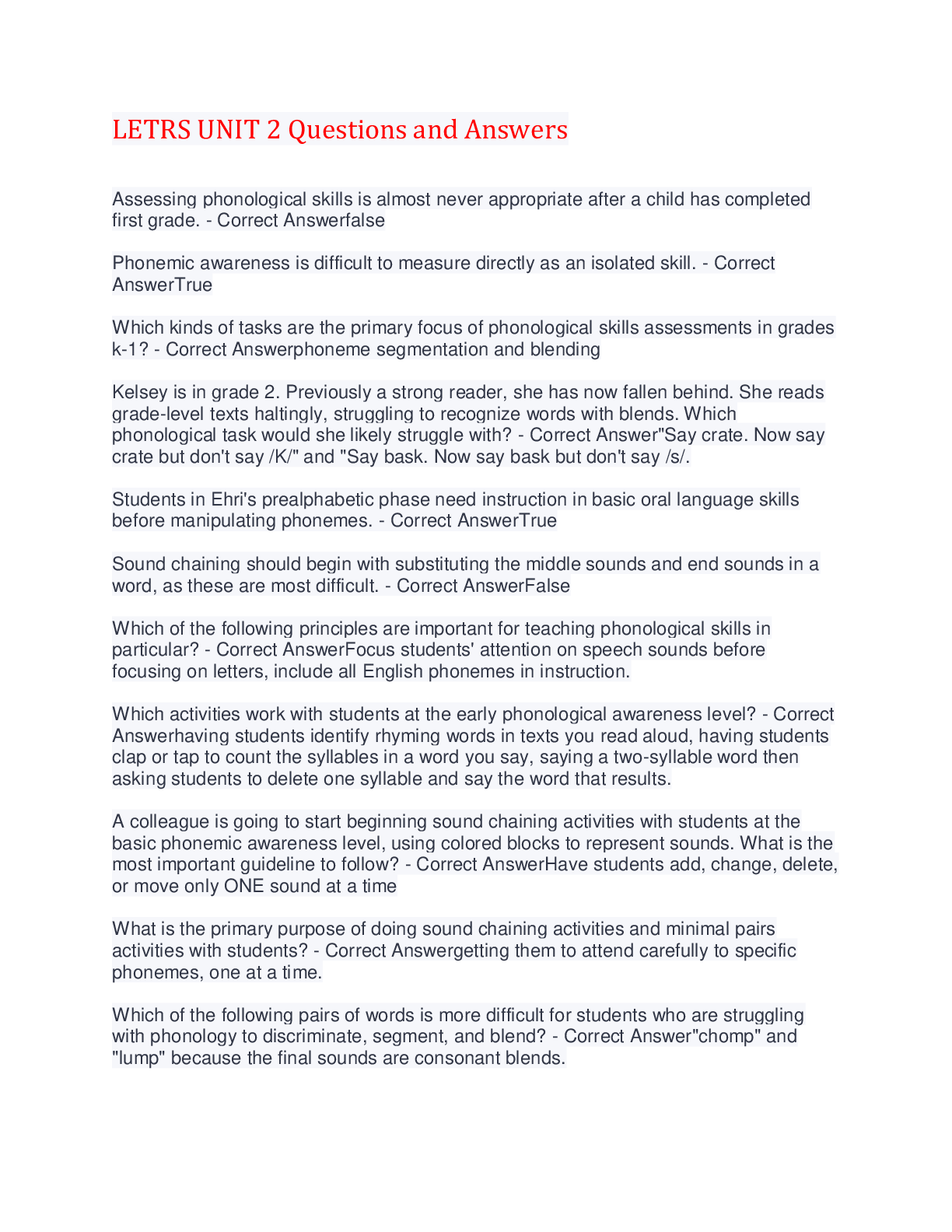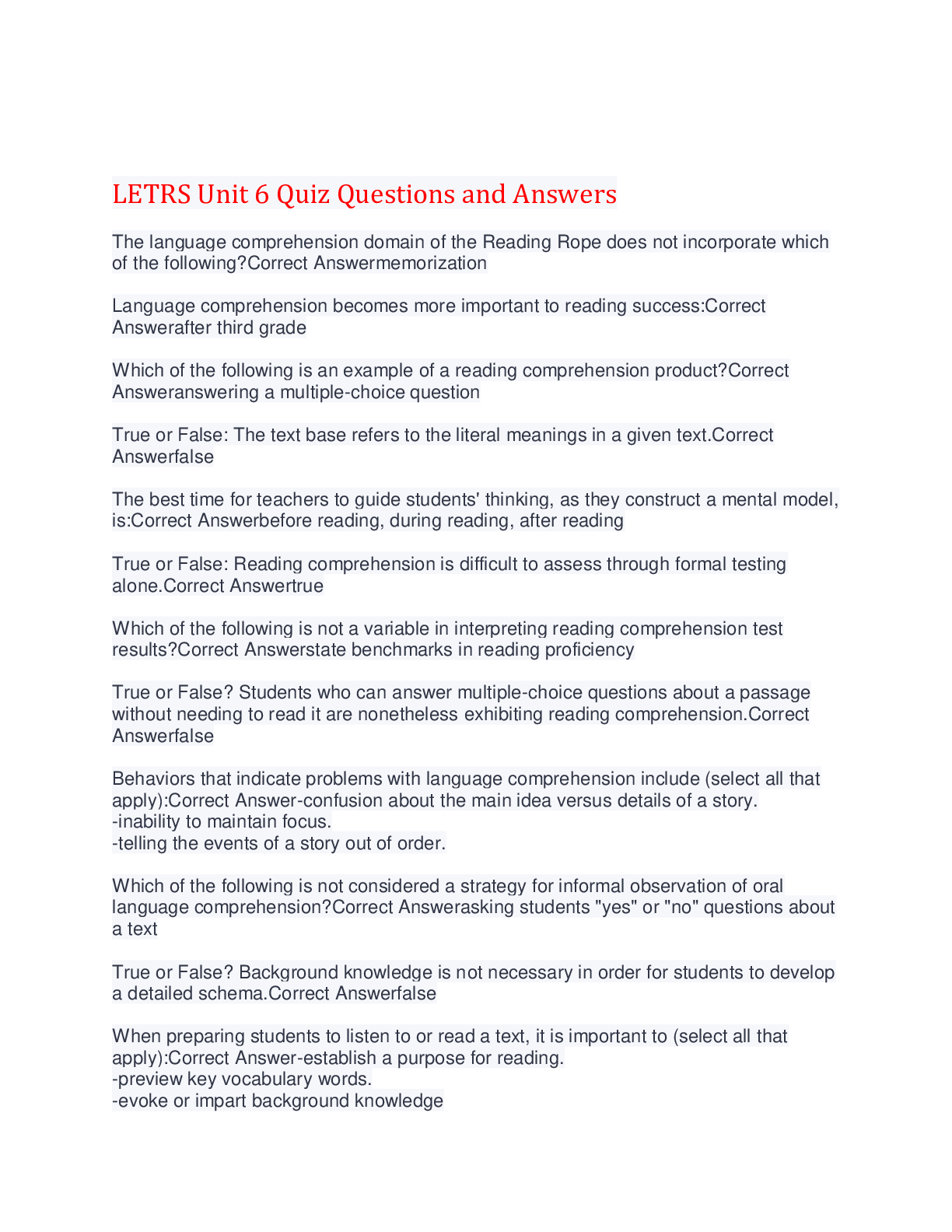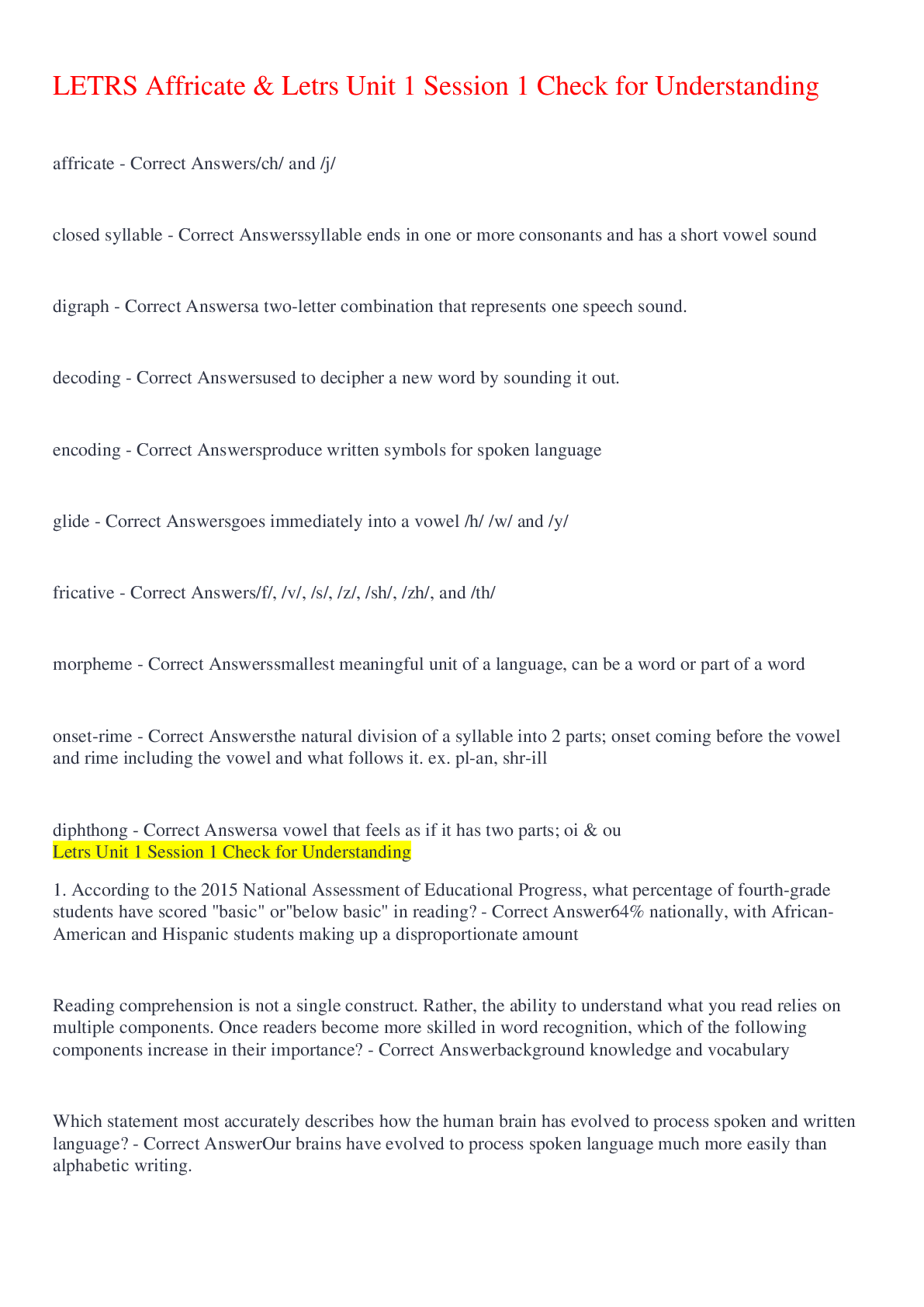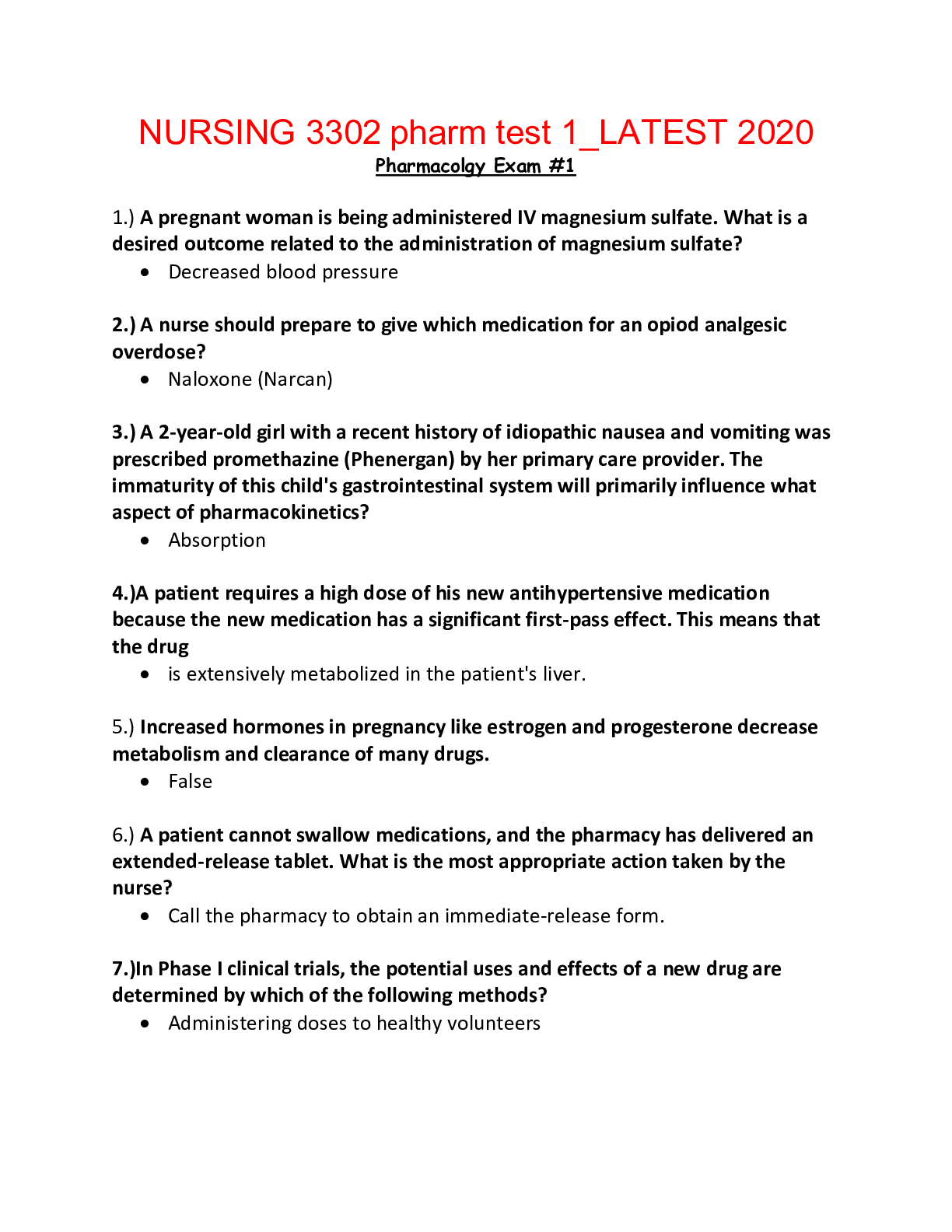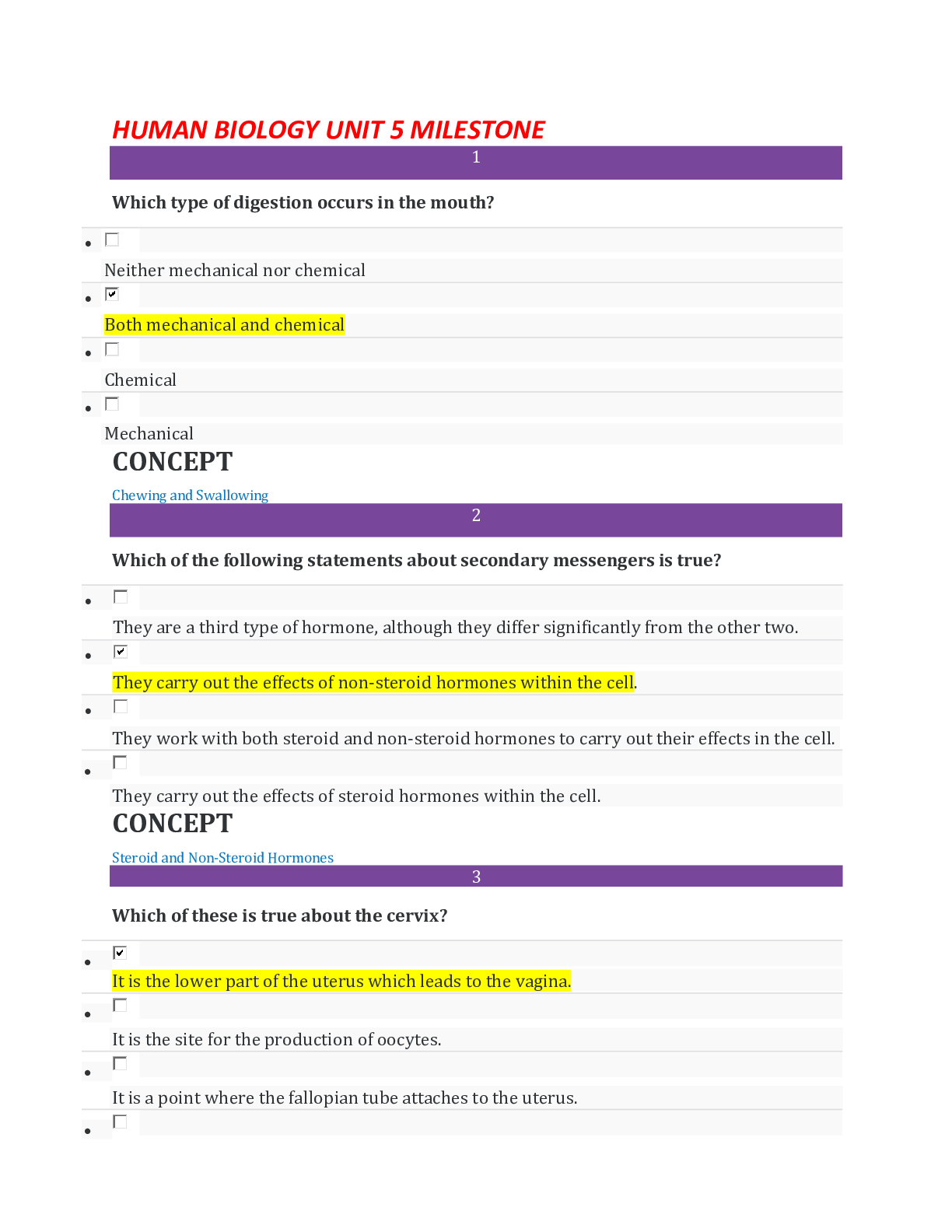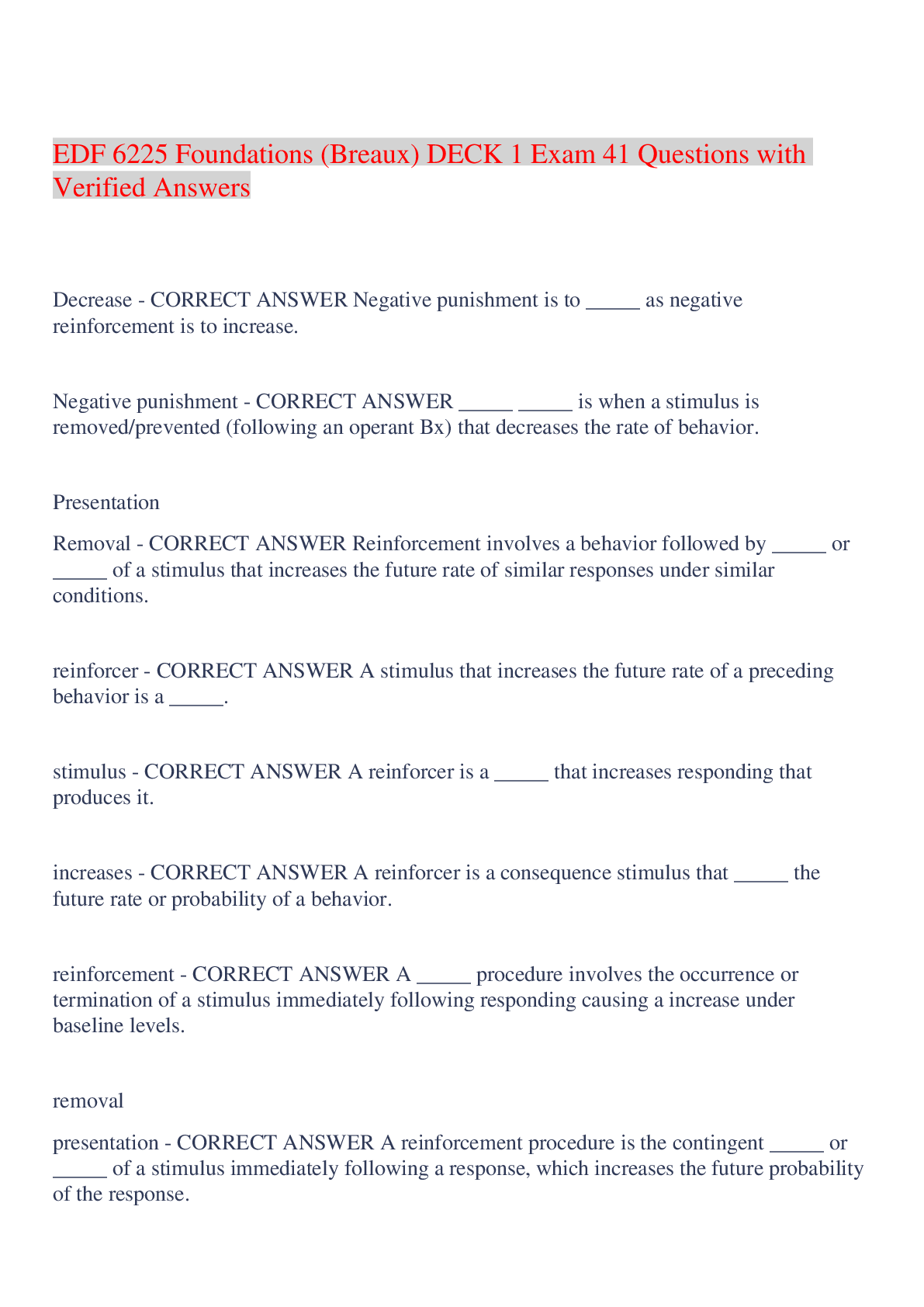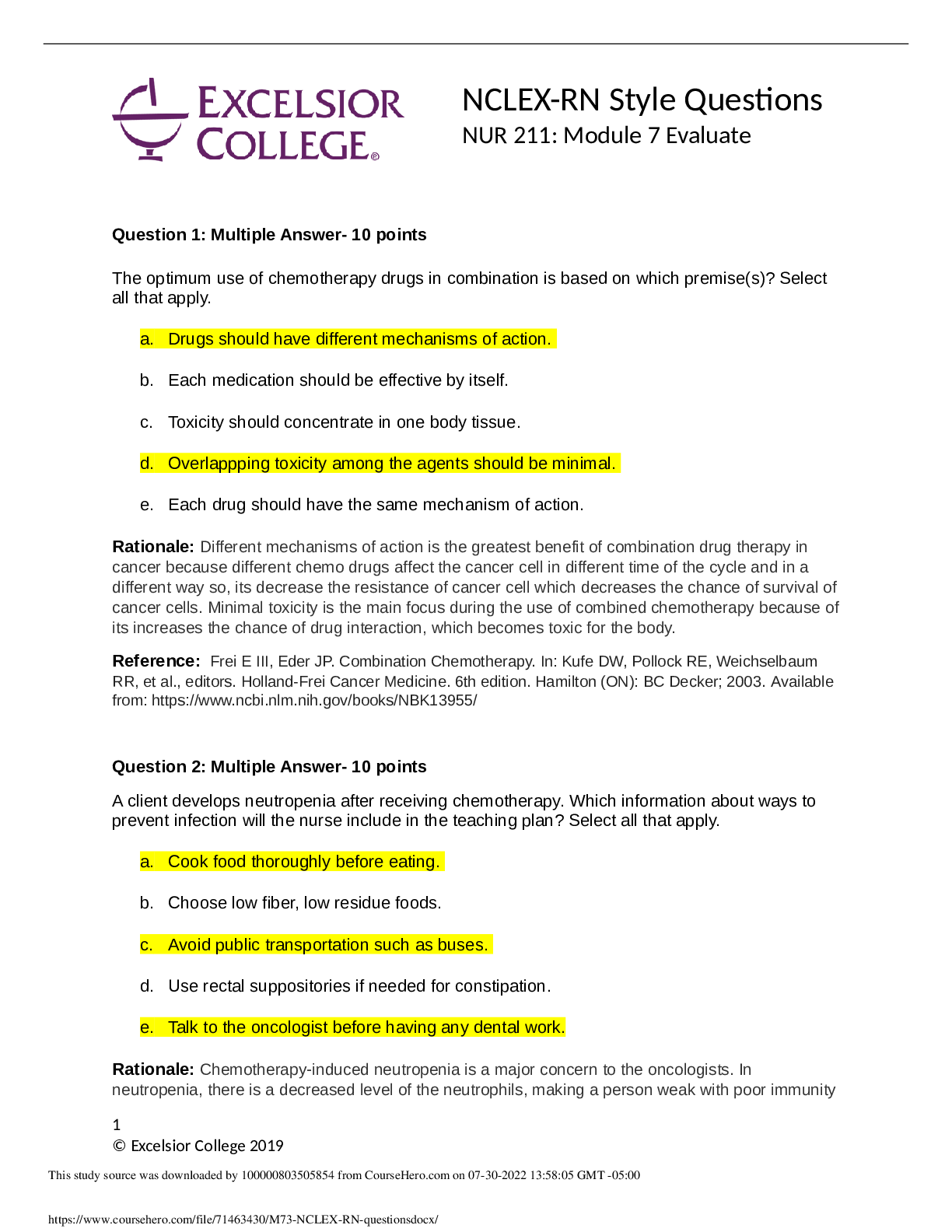ANATOMY SCIN 132 quiz 3 Questions & Answers,100% CORRECT
Document Content and Description Below
ANATOMY SCIN 132 quiz 3 Questions & Answers Question 1 of 32 3.0/ 3.0 Points Which of the following is/are true of the molecule named hemoglobin? • A. It numbers approximately 1 to 2 mil... lion in each erythrocyte. • B. It can bind to only one molecule of oxygen. • C. It is a very simple protein structure. • D. It contains four folded chains of a protein named globin. • E. It functions as the nucleus in all mature erythrocytes. Feedback:Good work; your answer is correct! Question 2 of 32 3.0/ 3.0 Points Which of the following is the primary function of red blood cells? • A. To bind some ions and molecules in the blood which are not water-soluble. • B. To bind and carry away waste products from most cells of the body. • C. To help in the process of hemostasis, the stoppage of blood flow following damage to a blood vessel. • D. To help fight off infection as part of the immune system. • E. To carry oxygen from the lungs to all cells of the body; to carry some carbon dioxide from the cells back to the lungs. Feedback:Good work; your answer is correct! Question 3 of 32 3.0/ 3.0 Points Which of the following is/are true of platelets? • A. Platelets are sometimes referred to as thrombocytes. • B. Platelets are actually pieces of large cells called a megakaryocytes. • C. Platelets are very small, but very numerous, sometimes numbering 150,000 to 160,000 per microliter of blood. • D. Platelets are critical to hemostasis, the stoppage of blood flow following damage to a vessel. • E. All of the above are true. Feedback:Good work; your answer is correct! Question 4 of 32 0.0/ 3.0 Points The blood type of a person’s blood depends on which of the following factors? • A. Which of the three antigens, A, B, and/or O, are located on the surface of the erythrocytes. • B. Which of two antigens, Rh+ or Rh-, are located on the surface of the erythrocytes. • C. Which of the two antigens, A or B or both, are located on the surface of the erythrocytes. • D. Whether or not the Rh antigen is found on the surface of the erythrocytes. • E. The blood type depends on both C and D. Feedback:The ABO part of the blood type depends on which of the A and B antigens, or both, or neither, are found on the surface of the erythrocytes. Whether the blood is Rh+ or Rh- depends on whether or not the Rh antigen is present. Question 5 of 32 3.0/ 3.0 Points Which of the following is/are true about the amount of oxygen being carried by RBCs? • A. Percent saturation of oxygen in the blood is normally monitored using a device known as a pulse oximeter. • B. The normal pulse oximeter readings range from 95--100%. • C. Lower pulse oximeter readings, e.g. less than 95%, are indicative of the condition named hypoxemia. • D. Many different diseases or conditions can result in hypoxemia. • E. All of the above are true. Feedback:Good work; your answer is correct! Part 2 of 7 - 12.0/ 15.0 Points Question 6 of 32 3.0/ 3.0 Points One of the most important ways of investigating the function of the heart is called the “cardiac output.” Which of the following facts is/are true? • A. Cardiac output, CO, is determined by multiplying the heart rate, HR, by the amount of blood that is pumped out of the left ventricle with each heart contraction, called “stroke volume” and designated as SV. • B. Is almost impossible to measure. • C. It cannot be measured without using very dangerous and invasive methods. • D. The CO will never change in any one individual. • E. All of the above are true. Feedback:Good work; your answer is correct! Question 7 of 32 3.0/ 3.0 Points By careful placement of surface electrodes on the body, it is possible to record the complex, compound electrical signal of the heart. This tracing of the electrical signal is the electrocardiogram (ECG). Which of the following statements is/are true? • A. A resting ECG usually takes approximately 1-2 hours to be recorded. • B. The ECG is useful for analyzing both normal and abnormal depolarizations of the heart. • C. To record an ECG, 12-electrodes are placed in a circular pattern around the person’s chest. • D. A normal ECG shows one single spike representing the contraction of the entire heart. • E. These electrodes are placed using needles deeply in the skin of the chest. Feedback:Good work; your answer is correct! Question 8 of 32 0.0/ 3.0 Points A cardiac muscle cell is: • A. a voluntary muscle just like skeletal muscle. • B. contracts spontaneously. • C. is joined to other cardiac muscle cells by structures called intercalated discs. • D. has numerous nuclei. • E. Two of the statements above are correct. Feedback:Cardiac muscle cells are totally involuntary and contract only when depolarized by electrical signals travelling from another source. Each cell has one or possibly two or three nuclei. They are highly dependent on the atom calcium. Question 9 of 32 3.0/ 3.0 Points The QRS-complex of an ECG represents which of the following: • A. The repolarizing of the ventricles. • B. The depolarizing of both atria. • C. The depolarization as it travels through the AV node. • D. The repolarizing of both atria. • E. The depolarization of the ventricles. Feedback:Good work; your answer is correct! Question 10 of 32 3.0/ 3.0 Points In case of damage to the SA node, there are other sites in the heart which can depolarize and establish a rate of contraction of the cardiac muscle cells. For example: • A. The cardiac muscle cells themselves can depolarize spontaneously at about 10 times per minute. • B. Various other cells in either atrium can establish a heart rate of 100-140 beats per minute. • C. The Purkinje fibers can themselves depolarize at rates of about 5-10 times per minute. • D. The bundle branches can each depolarize at rates of approximately 50-60 times per minute. • E. The AV node itself can depolarize at rates of 40-60 times per minute. Feedback:Good work; your answer is correct! Part 3 of 7 - 15.0/ 18.0 Points Question 11 of 32 0.0/ 3.0 Points Venous return is affected by all EXCEPT: • A. Skeletal and muscle activity • B. Values lining the veins • C. Thorax pressure changes • D. Temperature changes in the body • E. All of the above affect venous return. Feedback:The temperature changes do not affect venous return. Question 12 of 32 3.0/ 3.0 Points Capillaries that are lined with phagocytes are called . • A. Arterioles • B. Fenestrated capillaries • C. Venules • D. Continuous capillaries • E. Sinusoid capillaries Feedback:Good work; your answer is correct! Question 13 of 32 3.0/ 3.0 Points is a condition where the heart is beating over 100 beats per minute. • A. Arrhythmia • B. Irregular Heart Beat (IHR) • C. Tachycardia • D. Bradycardia • E. Nodal Block Feedback:Good work; your answer is correct! Question 14 of 32 3.0/ 3.0 Points These control the blood flow through a capillary bed. • A. Arterioles • B. Vasorum • C. AV values • D. Thoroughfare channel • E. Precapillary sphincters Feedback:Good work; your answer is correct! Question 15 of 32 3.0/ 3.0 Points What is the sequence of layers of the blood vessels (veins or arteries) from outside to the inside? • A. Tunica externa, tunica intima, tunica media • B. Tunica externa, tunica media, tunica intima • C. Tunica intima, tunica media, tunica externa • D. Tunica media, tunica externa, tunica intima • E. Tunica intima, tunica media, tunica externa Feedback:Good work; your answer is correct! Question 16 of 32 3.0/ 3.0 Points Which tunic of an artery is responsible for maintaining blood pressure? • A. Tunic intima • B. Tunica media • C. Tunica externa • D. Tunica interna • E. None of the above. Feedback:Good work; your answer is correct! Part 4 of 7 - 9.0/ 18.0 Points Question 17 of 32 3.0/ 3.0 Points The inflammatory response does not: • A. Replaces damaged tissue with healthy tissue • B. Prevents the spread of disease to surrounding tissues • C. Starts the repair process of the tissue • D. Disposes of the cellular debris • E. The inflammatory response does all of the above. Feedback:Good work; your answer is correct! Question 18 of 32 3.0/ 3.0 Points The cells responsible for humoral immunity are the . • A. B cells • B. Helper T cells • C. erythrocytes • D. Natural killer cells • E. platelets Feedback:Good work; your answer is correct! Question 19 of 32 0.0/ 3.0 Points The white pulp area in the spleen contains large amounts of . • A. Lymph • B. Red blood cells • C. Lymphocytes • D. Foam cells • E. Platlets Feedback:Lympocytes make up the white area in the spleen. Question 20 of 32 0.0/ 3.0 Points Fever: • A. Slows the body’s metabolic rate to conserve energy • B. Is always considered dangerous • C. Influences the liver to release large amounts of iron into the system • D. Is the resetting of the body’s temperature by chemicals. • E. Two of the above are correct. Feedback:Fever is when chemicals (pyrogens) reset the body’s temperature. Question 21 of 32 0.0/ 3.0 Points The majority of the lymph returns to the blood system by way of the . • A. Aorta • B. Both the superior and inferior vena cava • C. Thoracic duct • D. Right lymphatic duct • E. Cisterna chili Feedback:The thoracic duct returns over ¾ of the lymph from the body. Question 22 of 32 3.0/ 3.0 Points Part of the second line of defense includes: • A. Platlets • B. Antibodies • C. Cilia • D. Sebum on the skin • E. Phagocytes Feedback:Good work; your answer is correct! Part 5 of 7 - 18.0/ 21.0 Points Question 23 of 32 3.0/ 3.0 Points The repolarization of cardiac muscle is due to . • A. potassium entering the cell • B. potassium exiting the cell • C. sodium exiting the cell • D. sodium entering the cell Feedback:Correct! Question 24 of 32 3.0/ 3.0 Points The effect of the parasympathetic nervous system on the heart is to . • A. decrease the heart rate • B. increase the heart rate • C. increase the heart rate and increase the force of contraction • D. decrease the heart rate and decrease the force of contraction Feedback:Correct! Question 25 of 32 3.0/ 3.0 Points Excessive vagal stimulation of the heart will result in . • A. an increase in the force of contraction • B. a decrease in heart rate and, eventually, a temporary cessation of the heartbeat • C. an increase in heart rate • D. a decrease in the force of contraction Feedback:Correct! Question 26 of 32 0.0/ 3.0 Points The effect of vagus nerve stimulation on the heart is to . • A. decrease the heart rate • B. increase the heart rate • C. increase the heart rate and increase the force of contraction • D. decrease the heart rate and decrease the force of contraction Feedback:Learning Objective: Describe the effect of vagus nerve stimulation on heart rate. Please review Lab Exercise 6, Activity 2. Question 27 of 32 3.0/ 3.0 Points In the simulation, when vagus nerve stimulation was applied to the frog heart, . • A. the force of contraction increased • B. the force of contraction increased and the heart rate slowed and eventually stopped • C. the force of contraction decreased • D. the heart rate slowed and eventually stopped • E. the force of contraction decreased and the heart rate slowed and eventually stopped Feedback:Correct! Question 28 of 32 3.0/ 3.0 Points Research shows that in the absence of neural and hormonal influences, the sinoatrial (SA) node generates action potentials at a frequency of about 100 times per minute. However, the resting heart rate is about 70 beats per minute. What would the approximate heart rate be if the vagus nerve were severed? • A. about 70 beats per minute • B. faster than 100 beats per minute • C. about 100 beats per minute • D. slower than 70 beats per minute Feedback:Correct! Question 29 of 32 3.0/ 3.0 Points The effect of the sympathetic nervous system on the heart is to . • A. decrease the heart rate • B. increase the heart rate • C. increase the heart rate and increase the force of contraction • D. decrease the heart rate and decrease the force of contraction Feedback:Correct! Part 6 of 7 - 4.0/ 8.0 Points Answer the following question in your own words without using any resources. Your answer should be written in complete sentences using correct grammar, spelling, and terminology. Question 30 of 32 4.0/ 4.0 Points You used a simulated frog heart in this exercise. How does the frog heart differ from the human heart? A frog heart only has three chambers while a human heart has four. A frog heart contains only one ventricle. In addition, frogs have only one vessel leading into their hearts while humans have the Superior Vena Cava and the Inferior Vena Cava. Frogs also do not have pulmonary arteries however they have two arteries leading away from the heart while humans have only the Aorta. Feedback:Learning Objective: Compare and contrast the anatomical differences between the frog and human heart. Please review Lab Exercise 6, Activity 1. Question 31 of 32 0.0/ 4.0 Points Briefly explain why wave summation and tetany would be deadly in cardiac muscle. Wave summation and tetany create an inconsistency with the cardiac muscle group. Therefore as cardiac muscle s rely on consistency for survival either wave summation or tetany would be deadly to cardiac muscle. Feedback:Learning Objective: Explain why the absence of wave summation and tetanus is important to cardiac muscle function. Please review Lab Exercise 6, Activity 1. Comment:The heart would remain fully contracted and not be able to refill with blood; therefore, becoming ineffective as a pump. [Show More]
Last updated: 2 years ago
Preview 1 out of 20 pages

Buy this document to get the full access instantly
Instant Download Access after purchase
Buy NowInstant download
We Accept:

Reviews( 0 )
$17.00
Can't find what you want? Try our AI powered Search
Document information
Connected school, study & course
About the document
Uploaded On
Apr 16, 2021
Number of pages
20
Written in
Additional information
This document has been written for:
Uploaded
Apr 16, 2021
Downloads
0
Views
97


